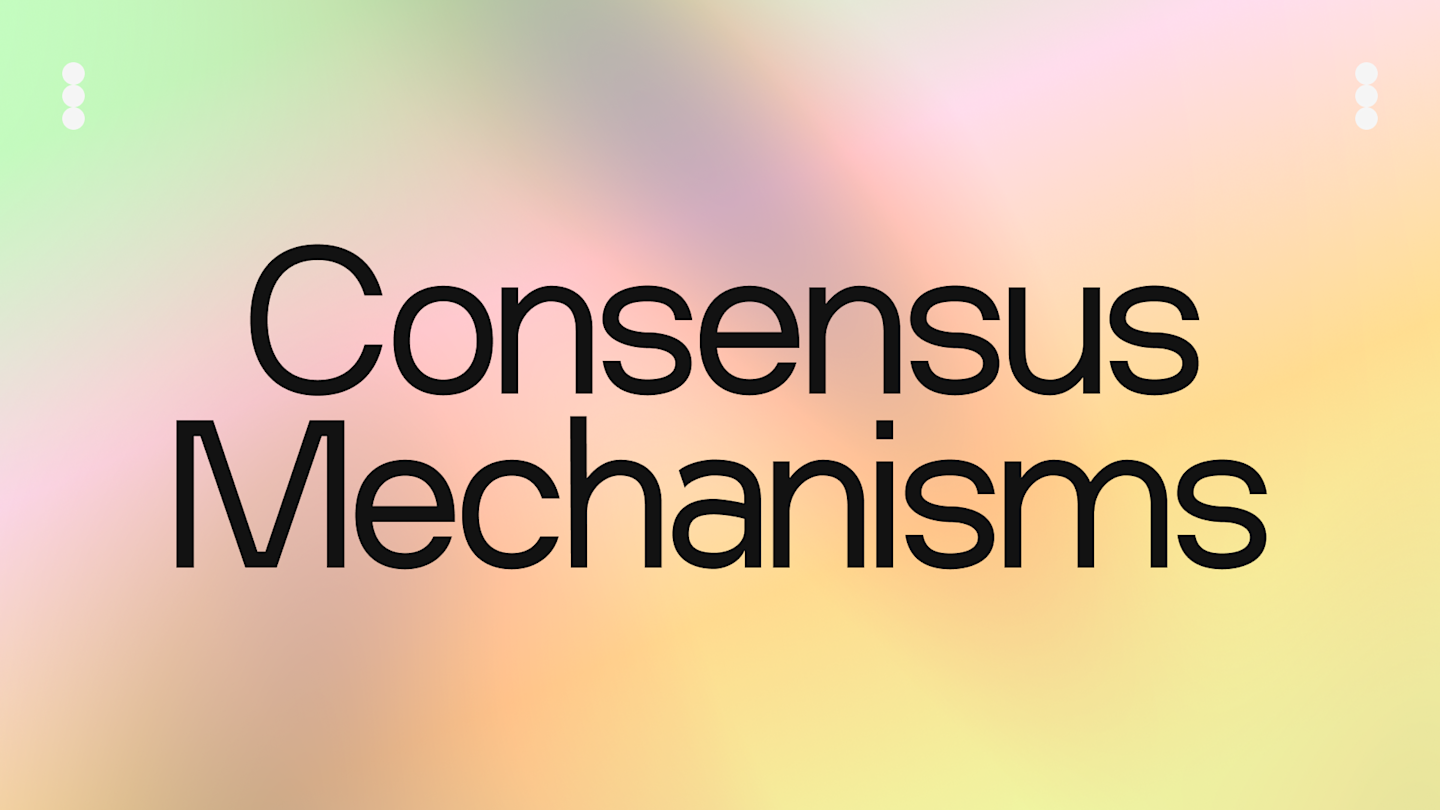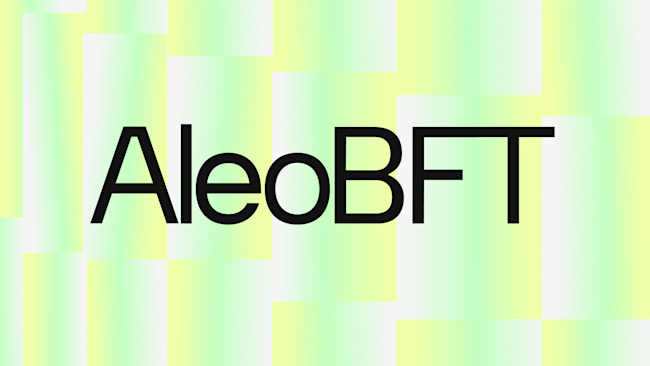Proof of Stake vs Proof of Work: A guide to consensus mechanisms

Consensus mechanisms serve as the foundational infrastructure of blockchain systems, defining how networks achieve agreement on the state of transactions without centralized authority. Each mechanism—whether it's Bitcoin's pioneering Proof of Work, Ethereum's transition to Proof of Stake, or Aleo's innovative Proof of Succinct Work— has pros and cons when it comes to application performance, security guarantees, and scalability potential.
In this article, we'll explore the technical characteristics and development tradeoffs of both PoW and PoS systems, before examining how Aleo's Proof of Succinct Work introduces a novel approach that combines robust security with computational efficiency.
What is Proof of Work (PoW)?
Proof of Work was the first blockchain consensus mechanism implemented by Bitcoin. From a developer's perspective, PoW represents a battle-tested but resource-intensive approach to consensus.
Technical considerations
Proof of Work operates on the principle of probabilistic finality, where transactions gain security incrementally as more blocks are added to the chain. This means developers must account for the possibility of chain reorganizations in their application design. The security of a PoW blockchain scales directly with the computational power dedicated to mining, making hashrate a critical metric for evaluating network security.
The protocol automatically calibrates puzzle difficulty to maintain consistent block times despite fluctuations in network hashrate. This self-adjusting mechanism ensures predictable performance for applications built on PoW chains. One of the strongest security properties of PoW is that an attacker would need to control 51% of the network's hashrate to potentially reorganize the blockchain—an increasingly expensive proposition as the network grows.
Development tradeoffs
When building on PoW networks, developers must contend with fundamental throughput limitations imposed by block size and time constraints. Bitcoin, for example, processes only about 7 transactions per second, which can create bottlenecks for applications during periods of high demand. Settlement time presents another challenge, as applications typically require multiple block confirmations (6+ blocks on Bitcoin) to achieve reasonable security assurances, resulting in wait times of an hour or more for high-value transactions.
The significant computational resources required for securing these networks translate to higher transaction costs. Additionally, the inherent high latency of PoW consensus makes these networks less suitable for applications requiring real-time finality, such as gaming or DeFi.
What is Proof of Stake (PoS)?
Proof of Stake emerged as an energy-efficient alternative to PoW. Instead of competing with computational resources, validators are selected based on the number of tokens they've staked.
Technical considerations
Proof of Stake fundamentally changes the security model from computational to economic. A protocol’s security is tied directly to the value of staked tokens, creating an economic moat against attacks. Many PoS systems offer faster or even immediate transaction finality, which allows developers to build applications with more responsive user experiences and reduced settlement risk.
The protocol enforces good behavior through slashing conditions, where validators face economic penalties for malicious or negligent actions. This mechanism also addresses the "Nothing-at-Stake" problem, preventing validators from attempting to validate multiple competing chain forks simultaneously—a theoretical vulnerability in early PoS designs that has been effectively solved in modern implementations.
Development tradeoffs
PoS networks generally offer higher transaction throughput compared to their PoW counterparts. Settlement times are often faster in PoS systems, since there is no need to do heavy computation to propose a new block, enabling more responsive application experiences.
Resource efficiency stands as one of the most compelling advantages of PoS for modern developers. These networks consume dramatically less energy than PoW systems—by some estimates, reducing energy usage by over 99%. However, PoS comes with its own challenges, particularly around initial token distribution. Without careful design, these systems can suffer from excessive centralization, as wealthy early participants may gain disproportionate control over network governance and rewards.
Proof of Stake vs. Proof of Work
When architecting your blockchain application, several technical distinctions will impact your design decisions. PoW relies on computational puzzles to select block producers, while PoS uses token stake and selection algorithms to choose validators.
Different fork choice rules also govern how the network reaches consensus. PoW typically follows the longest chain rule, where the chain with the most accumulated work is considered valid. PoS systems often employ more complex algorithms like LMD GHOST to determine the canonical chain state. LMD GHOST is a fork choice rule used in Ethereum 2.0 that selects the chain by following the path with the greatest accumulation of validator votes through the tree of blocks.
The security models also differ significantly. PoW networks require attackers to amass massive computational resources, making attacks prohibitively expensive as the network grows. PoS systems tie security to economic stake, requiring attackers to control a significant portion of the staked tokens (typically 33% or more) to threaten network integrity.
For smart contract developers, these differences affect practical considerations like transaction finality, MEV exposure, and gas optimization strategies. Each consensus mechanism presents different tradeoffs in confirmation times, vulnerability to front-running, and cost structures for various operations.
Proof of Succinct Work (PoSW): Aleo's Developer-First Approach
Aleo introduces a novel consensus mechanism: Proof of Succinct Work (PoSW) which combines the security guarantees of work-based systems with the efficiency advantages of modern cryptography. The system transforms computational work from being purely competitive to productive—miners generate SNARK proofs that directly contribute to improving efficiency in proof generation that can translate to faster transaction confirmation time and better UX.
The inherent succinctness of zk-SNARK proofs reduces the computational resources required for network validation. This translates to better scalability, lower transaction costs, and a network capable of handling increased transaction volumes without compromising performance. As blockchain networks grow, validating and verifying transactions typically becomes increasingly resource-intensive, but Aleo's PoSW offers a scalable solution.
Succinct verification is another key advantage for developers building on Aleo. Proofs are compact and efficient to verify, dramatically reducing on-chain overhead compared to traditional transparent systems. This efficiency translates to better scalability and lower transaction costs. The platform also offers programmable privacy, where developers can implement selective disclosure mechanisms that balance user privacy with regulatory compliance needs.
Developers can also leverage Aleo's specialized programming language, Leo, to build private applications with performance and scalability in mind, without the excessive resource requirements of traditional PoW or the potential centralization risks of PoS.
Ready to build?
Start developing on Aleo today and leverage the power of Proof of Succinct Work for your decentralized applications.


